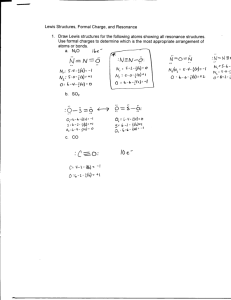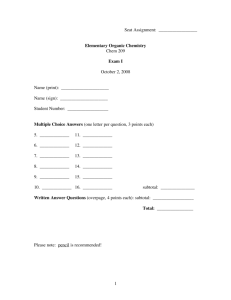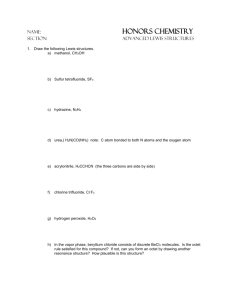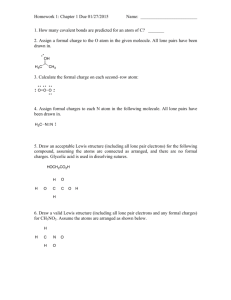CH3
advertisement
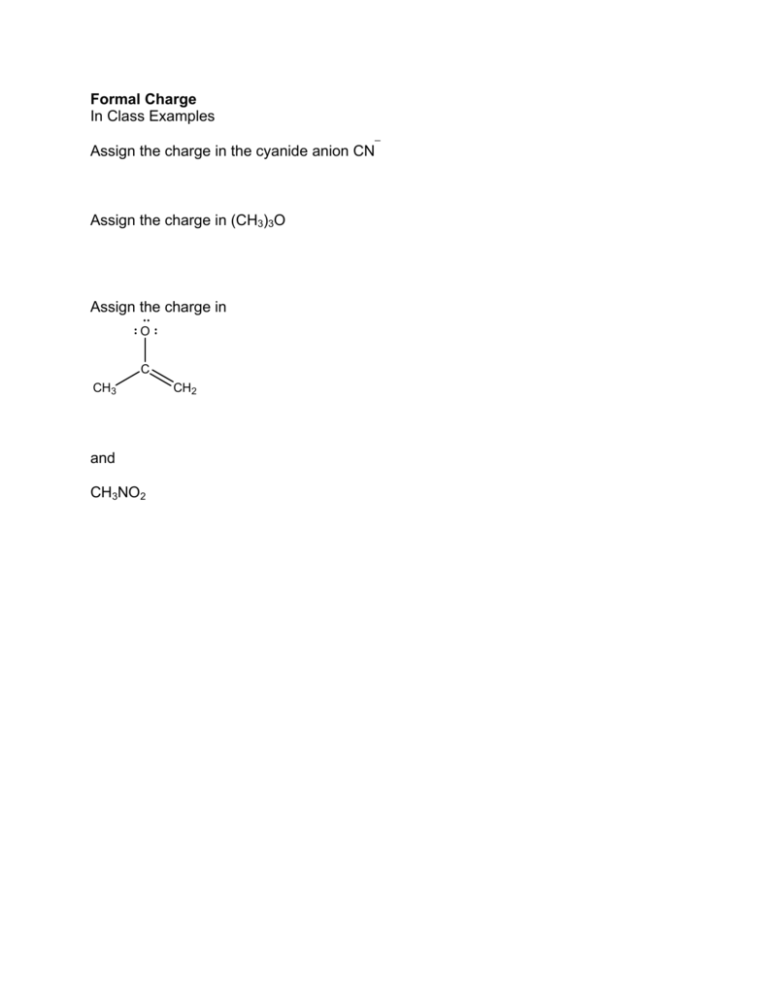
Formal Charge In Class Examples Assign the charge in the cyanide anion CN¯ Assign the charge in (CH3)3O Assign the charge in O C CH3 and CH3NO2 CH2 Resonance For certain structures we can write more than one line bond or Lewis structure. Resonance and Benzene Structure Two resonance structures for benzene H C H H H C C C C H H H C H H C H C C C C H C H One example is nitromethane. Which of the two is correct? Do we actually observe different N-O bond lengths? The answer to the later question is no both N-O bonds have identical length. So in fact the molecule exists as hybrid of both structures. O O H3C H3C N O N O See the same for the nitrate anion -1 O N O O N N N O O O O O O O O O Resonance and Estimation of the Relative Importance of Resonance Forms Resonance structures exist only on paper. Resonance structures are useful because they allow us to describe molecules, radicals, and ions for which a single Lewis structure is inadequate. We write two or more Lewis structures, calling them resonance structures or resonance contributors. The structures are connected by double headed arrows, and we say that the real molecule, radical or ion is like a hybrid of all of them. In writing resonance structures we are only allowed to move electrons. The positions of the nuclei must remain the same in all of the structures. All of the structures must be proper Lewis structures. We should not write structures in which C is pentavalent for example. All resonance structures must have the same number of unpaired electrons. All atoms that are part of a delocalized system must lie in a plane or be nearly planar. The energy of the actual molecule is lower than the energy that might be estimated for any contributing structure. Equivalent resonance structures make equal contributions to the hybrid and a system described by them has a large resonance stabilization. Non equivalent structures do not make equal contributions to the hybrid. The more stable a structure, the greater is its contribution to the hybrid. Guidelines to decide how to assign relative importance to different resonance structures are as follows:- Two Non Equivalent Resonance Structure of an Enolate Ion H H C H H C H C O H C O Guideline 1. Full Valence Shell Increases Stability Structures with a maximum of octets are preferred. In the enolate ion, all component atoms in either structure are surrounded by octets. Consider, however, the nitrosyl cation, NO+ : The better resonance form has a positive charge on oxygen with electron octets around both atoms; the other places the positive charge on nitrogen, thereby resulting in an electron sextet on this atom. Because of the octet rule, the second structure contributes less to the hybrid. Thus, the N–O linkage is closer to being a triple than a double bond and more of the positive charges is on oxygen than on nitrogen. Nitrosyl cation N O N Major resonances contributor O Minor resonances contributor Guideline 2. Charges should be preferentially located on atoms with compatible electronegativity. Consider again the enolate ion. Which is the preferred resonance structure? Guideline 2 requires that it is the first, in which the negative charge resides on the more electronegative oxygen atom. Looking again at NO+, you might find guideline 2 confusing. The major resonance contribution to NO+ has the positive charge on the more electronegative oxygen. In cases such as this, the octet rule overrides the electronegativity criterion; that is, guideline 1 takes precedence over guideline 2. Guideline 3. Charge Separation Decreases Stability. Structures with a minimum of charge separation are preferred. This rule is simple consequence of Coulomb's law: Separating charges requires energy; hence neutral structures are better than dipolar ones. Formic acid O H O C O H H C Major O H Minor In some cases, to ensure octet Lewis structures, charge separation is acceptable; that is, guideline 1 takes precedence over guideline 3. An example is carbon monoxide. Carbon monoxide C O Major C O Minor When there are several charge-separated resonance structures that comply with the octet rule, the most favourable is the one in which the charge distribution best accommodates the relative electronegativities of the component atoms (guideline 2). In diazomethane, for example, nitrogen is more electronegative than carbon, thus allowing a clear choice between the two resonance contributors. H Diazomethane H C N H N C N H Major Minor N Representation of Structural Formulas Different types of formula are dot formula, dash formula condensed formula and Bondline formula. Often lone pairs are omitted but it is a good idea to include them on all structures where they are present. Condensed Formulas In these widely used structural formulas, the bonding is implied by the order in which the atoms appear. The sequence of central atoms is written from left to right. The hydrogens and other atoms that are bonded to a central atom appear immediately after that central atom. A Constitutional Isomer of C2H6O H H H C O C H H H Lewis Dot Structure H H H C O C H H H Dash Formula CH3OCH3 Condensed Formula Representations of Structural Formulas Dot Structures (Lewis Structures) There are a number of ways to write structural formulas. Each conveys some idea or information about the structure. These structures emphasize the number of valence electrons. They help in recognizing a correct valence bond structure in conjunction with the octet rule. But using dots for covalent bonds is tedious, and they are rarely used . Dash or Line Formulas These structural formulas where each pair of electrons in a covalent bond is represented as a line are widely used. When the nonbonding electron pairs are shown as dots, these formulas provide an accounting of all the valence electrons. Sometimes the nonbonding electrons are omitted. Equivalency of Dash Structural Formulas Dash structural formulas may, to the inexperienced eye, appear to be nonequivalent, when, in fact, they represent the same compound. Because of rotation around single bonds, it is possible to have several perspectives of a structure that are drawn in different dash formulas . They all represent the same structure. H H H C C OH H H H H H OH H H ethyl alcohol H may be shown as H C H H H C H H C H OH OH C H H equivalent Condensed Structural Formulas These shorthand formulas with implied bonding are widely used. Sometimes some partial line formulas are included to emphasize a structural detail. Dash or Line Formulas Condensed Structural Formulas (All covalent bonds are shown.) H H H C C OH H H H H H H H C C C C H H Cl Cl H (Note use of parentheses to enclose groups.) H H H H H C C C C H H H H H C H H (Bonds are implied.) CH3CH2OH CH3CHClCHClCH3 or CH3CHCHCH3 Cl Cl CH3CH(CH3)CH2CH3 or CH3CHCH2CH3 CH3 or (CH3)2CHCH2CH3 Bond-Line Formulas and Cyclic Molecules Bond-line formulas are short-hand representations where atoms are not explicitly shown. The carbon skeleton is drawn by lines. Only atoms and groups other than hydrogen are shown. Each intersection of two or more lines is a carbon center. Multiple bonds are shown.. Cl CH3CH2CH3 CH3CHCH2CH3 CH3 CH3CHClCH3 CH3CHCHBrCH3 CH3 Br Cyclic structures are shown as regular polygons. H2 C H2 C H2C H2C CH2 H 2C Multiple bonds are shown. CH3 CH3C=CHCH3 CH2 CH2 Three-Dimensional Representations Three-dimensional representations of structures are often important. By convention, a solid wedge is a bond projected out of the plane of paper or screen towards the viewer. A dashed wedge is a bond projected out of the plane away from the viewer. A solid line is a bond in the plane. towards viewer in plane away from viewer Examples H Br H C H CH3Br H Cl C H H OH CH3OH H3C H C H CH3CH2Cl Quiz Chapter 1 Section 17 Are the following pairs of structural formulas the same or different compounds? (CH3)2CHCH2CH3 CH3CH2CHCH3 CH3 CH3CH2CHClCHCH3 CH3CH2CHClCHCH2CH3 CH2CH3 CH3 CH3CHCH2CHCH2CH3 CH3 Cl (CH3)2CHCHClCH2CH2CH3

